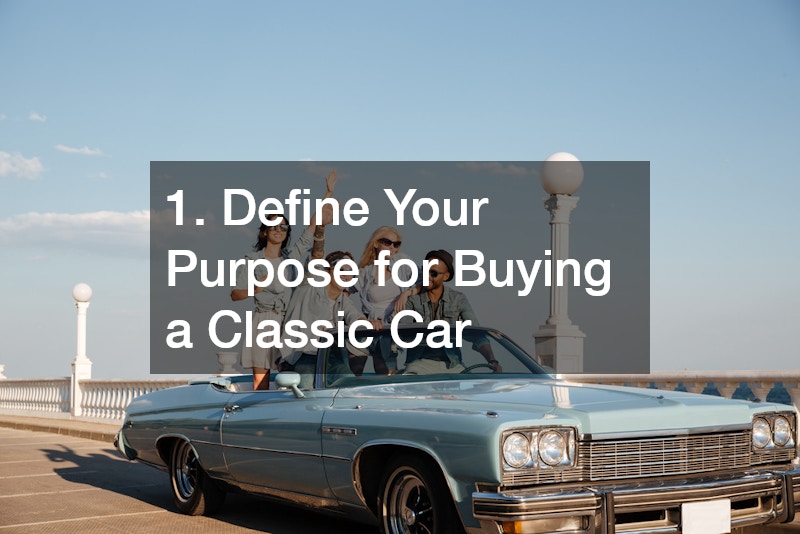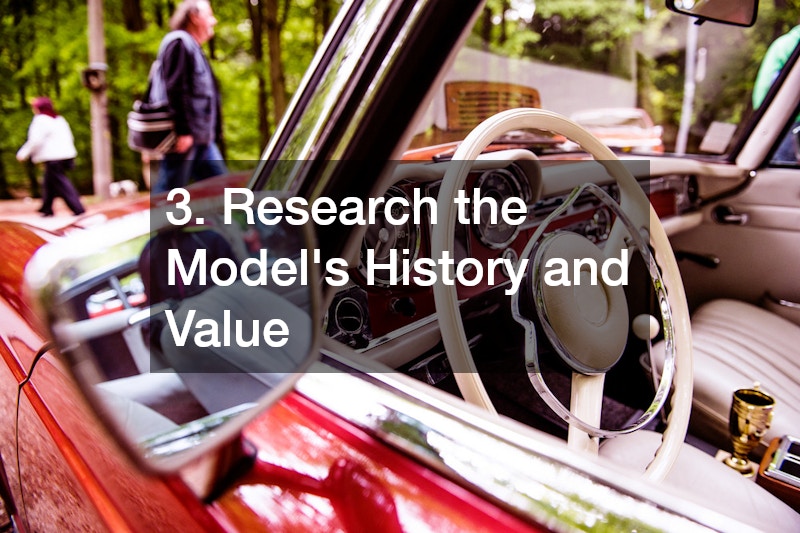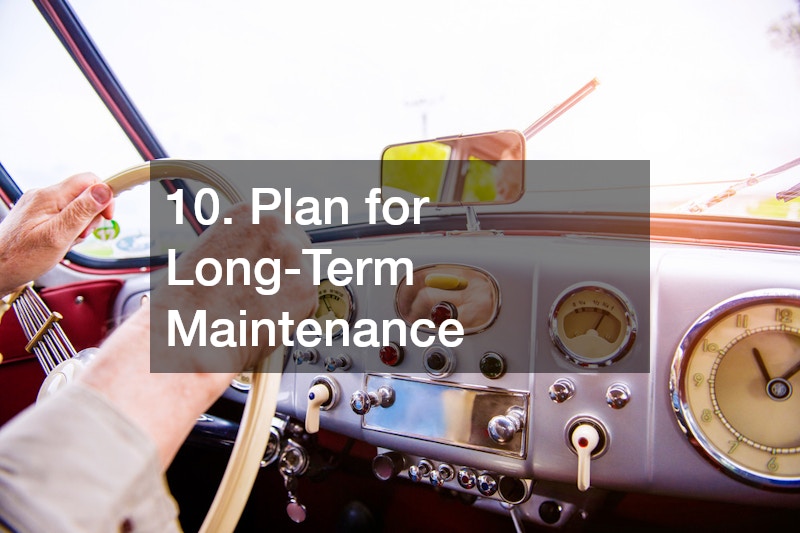
Buying your first vintage ride can be a thrilling experience, but it’s also an investment that requires careful thought and planning. Classic cars are more than just a mode of transportation; they’re symbols of craftsmanship, nostalgia, and often a passion for automotive history. Whether you’re looking to restore a classic car or drive it as-is, there are several key factors to consider before making that big purchase. This guide will walk you through the 10 most important things to consider when buying your first vintage ride.
1. Define Your Purpose for Buying a Classic Car

Before diving into the world of classic cars, it’s essential to ask yourself why you’re buying one in the first place. Your purpose will not only shape the type of car you choose but also how much you’re willing to spend and how you’ll treat your new ride.
- Are you looking for a daily driver? Some classic cars are practical enough to drive regularly, though keep in mind they may not be as reliable or efficient as modern vehicles.
- Are you buying as an investment? Certain models appreciate over time, and purchasing a car as an investment requires a good understanding of the market.
- Do you want a project car? If you’re passionate about restoring a vehicle, a fixer-upper may be right for you, but it’s crucial to understand the time, skills, and budget that restoration will require.
Understanding your primary objective will guide every decision, from the make and model to the condition of the car you buy.
2. Set a Realistic Budget
Setting a realistic budget is one of the most important steps in purchasing a classic car. Classic cars can range from affordable project cars to high-end collector’s items, and knowing your financial boundaries will keep you from getting overwhelmed.
Initial Purchase Price:
Vintage cars can be expensive, with some rare models costing hundreds of thousands of dollars. Set a limit on how much you’re willing to pay upfront, including the cost of any necessary auto repair or restoration.
Maintenance and Repairs:
Classic cars require ongoing maintenance. Budget for routine auto repairs, replacement parts, and occasional upgrades.
Insurance and Registration Costs:
Classic car insurance is often more expensive than regular car insurance, especially if the car is valued highly. Check with insurance companies about classic car policies.
By establishing a realistic budget, you avoid the temptation to overspend and ensure that you can afford the total cost of ownership.
3. Research the Model’s History and Value

Each classic car has a unique history, and it’s essential to understand the model you’re interested in before making a decision. Researching the car’s value, rarity, and any common issues specific to that model will help you make an informed purchase.
Model Research:
Learn about the car’s production years, production numbers, and any known issues that might affect its longevity or value.
Value Assessments:
Classic car values fluctuate, so research current market trends. Look at auction results, pricing guides, and online listings for comparable cars to get an accurate estimate of a model’s worth.
Ownership History:
A well-documented history of ownership can affect the car’s value. Check for any documentation like service records, ownership transfers, and restoration work.
The more you know about the history and value of the classic car model you’re considering, the better equipped you’ll be to make a sound decision.
4. Inspect for Rust, Structural Integrity, and Glass Condition
Rust is the enemy of beautiful classic cars, and its presence can significantly impact the car’s value and longevity. A thorough inspection is essential before buying a vintage ride.
Common Rust Spots:
Check areas prone to rust, such as the undercarriage, wheel arches, door sills, and floorboards. Pay special attention to the car’s frame, as rust in structural areas can compromise safety.
Structural Integrity:
Beyond just rust, assess the overall structure of the vehicle. Look for signs of previous accidents or poorly executed repairs that could affect the car’s frame and alignment.
Auto Glass Condition:
While inspecting the body and frame, don’t overlook the windows and windshield. Check for any cracks, chips, or cloudiness in the glass. A damaged windshield or windows may be costly to replace, especially if the car is a rare model with specific auto glass requirements.
Check for Repairs:
If you notice rust or any issues with the auto glass, ask the seller about previous repairs. Were they done properly with quality materials, or did they merely mask the issue? An auto repair company can give you an expert opinion on whether any prior repairs were done correctly.
A solid, rust-free body and clear, undamaged glass are crucial for preserving the vehicle’s value and avoiding expensive repairs down the line.
5. Evaluate the Mechanical Condition
The mechanical condition of a classic car is just as important as its body. A car that looks great on the outside may still require costly mechanical work.
Engine and Transmission:
Check for leaks, strange noises, and signs of wear. If the engine runs rough or the transmission slips, the auto repair costs can be high. In some cases, major issues may require car engine replacements, which can be quite expensive but necessary to maintain the car’s performance and value.
Suspension and Brakes:
The suspension system and brakes are critical for safety and ride quality. Inspect for worn bushings, leaking shocks, and signs of uneven brake wear. The suspension system and brakes are critical for safety and ride quality. Inspect for worn bushings, leaking shocks, and signs of uneven brake wear. If any components are showing signs of wear or damage, it may indicate the need for auto brake repairs or suspension adjustments.
Electrical Systems:
Many classic cars have outdated wiring that can be prone to failure. Ensure that the car’s electrical system is functioning properly, especially lights, signals, and the battery.
Don’t just assume the car is in good mechanical shape because it drives well for a short distance. Have a qualified mechanic do a thorough inspection.
6. Check for Authenticity and Matching Numbers
When buying a classic car, authenticity matters. Cars with matching numbers—meaning the engine, transmission, and body components are original to that specific vehicle—are typically more valuable.
Matching VIN and Engine Numbers:
Check the car’s Vehicle Identification Number (VIN) and ensure it matches the engine and other critical parts. If the numbers don’t match, this may affect the car’s value.
Original Parts vs. Reproduction Parts:
Verify if the car still has its original parts or if any components have been replaced with reproductions. Original parts can increase a car’s value, especially if they are in good condition.
Classic car enthusiasts and collectors often prioritize originality, so authenticity is key if you’re looking to maximize the car’s value or resale potential.
7. Assess Restoration Needs and Costs

Restoring a vintage car can be a rewarding project, but it can also be expensive and time-consuming. Be sure to assess the amount of work the car needs and the costs involved before making a decision.
DIY Restoration vs. Professional Work:
Determine whether you’re planning to do the restoration yourself or hire professionals. DIY restorations can save money but require skill, while professional restorations can be costly but yield high-quality results.
Parts Availability:
The availability of replacement parts can vary depending on the make and model. Some older cars may have limited parts availability, making restoration more difficult and expensive.
Estimate Restoration Costs:
Calculate how much it will cost to restore the car to your desired condition. If the car has visible body damage, be prepared for potential costs related to auto dent repair. Consider whether the restoration investment will pay off in terms of the car’s future value.
Understanding the restoration needs will help you determine whether the project is worth taking on, or if you should consider a car in better condition.
8. Understand Classic Car Insurance Requirements
Insurance for classic cars is different from regular car insurance. Classic car insurance policies offer specific coverage designed for vintage vehicles, and it’s crucial to understand these requirements before purchasing a classic car.
Agreed Value vs. Actual Cash Value:
Classic car insurance typically uses an agreed value policy, where the insurer agrees on the value of the car upfront. In case of a loss, you receive the agreed-upon amount rather than the car’s depreciated value.
Mileage Limits:
Many classic car insurance policies have mileage limits, as classic cars are often not driven daily. Ensure the policy terms align with how often you plan to drive the car.
Storage and Security:
Some insurance companies may require that the car be stored in a garage or under a cover to protect it from damage and theft. Additionally, having security features like an alarm may lower premiums.
Shop around for classic car insurance quotes and understand the policy details to ensure you’re fully covered.
9. Consider Long-Term Storage
When it comes to classic cars, long-term storage is key to maintaining their value and condition. If you don’t plan on driving your vintage car regularly, it’s important to store it properly to avoid damage from the elements.
Indoor Storage:
A climate-controlled environment is ideal for preserving your car. Storing your classic car in a custom garage or storage facility with controlled temperature and humidity levels helps prevent rust, fading, and the deterioration of materials. It’s also a good idea to cover the car with a breathable cover to protect it from dust and debris while allowing airflow.
Protect from the Elements:
Exposure to harsh weather, especially extreme heat, cold, and rain, can accelerate the wear and tear on a classic car. If indoor storage isn’t an option, consider investing in a high-quality car cover designed to shield against rain, UV rays, and environmental contaminants. Keep the car elevated off the ground with jack stands to reduce pressure on the tires and suspension during prolonged storage.
Long-Term Parking Considerations:
If you need to store your classic car for an extended period (such as during the off-season), be sure to take precautions. Clean the car thoroughly to remove any dirt or contaminants that can cause corrosion. You might also want to disconnect the battery and add a fuel stabilizer to prevent fuel from degrading over time.
10. Plan for Long-Term Maintenance

Regular maintenance is crucial for keeping a classic car running smoothly, especially if it’s not driven frequently. While these cars are designed to last, neglecting maintenance can lead to costly repairs down the road.
Fluid Care:
One of the most important aspects of long-term maintenance is keeping up with fluid changes. Even if the car isn’t driven regularly, fluids like oil, brake fluid, and coolant can deteriorate and lead to engine damage. Make sure to schedule oil changes at least once a year and top off other fluids as needed.
Tire and Brake Maintenance:
Tires can develop flat spots from sitting in one place for too long. To prevent this, rotate the tires every few months or elevate the car if it’s not in use for an extended period. Likewise, check the brake pads and fluid regularly to ensure they remain in good condition and ready for action when you need them.
Engine and Electrical Care:
Even when not in use, starting the engine every few weeks and running it for a short period can help maintain the mechanical components and prevent seals from drying out. If you store the car for an extended time, it’s advisable to have the electrical system checked, especially if you’re not regularly running the car.
Routine Inspections:
In addition to fluid care and engine maintenance, make sure to schedule an annual inspection with a professional mechanic experienced with beautiful classic cars. They can identify potential issues before they become serious problems and ensure your car remains roadworthy.
Exterior Care:
To keep your car looking its best, don’t forget the exterior. Periodic visits to professional car detailers can ensure that the paint is properly maintained, helping to protect it from weather damage and keeping the car looking like new.
Final Thoughts
Buying your first vintage ride is an exciting adventure, but it’s also a process that requires careful consideration. By defining your purpose, setting a budget, conducting thorough research, and taking all the necessary precautions, you can ensure that your classic car purchase is a wise investment that brings joy for years to come. Whether you’re restoring a beauty, driving it daily, or simply enjoying it as a collector’s item, the right classic car can be a truly timeless treasure.
